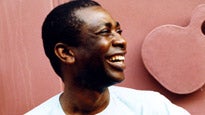
Originaire du Wassoulou,
Tom Diakité fait partie des artistes maliens qui ont, à un moment donné, émerveillé le public, avant de s'éclipser comme une étoile filante. Dans sa tendre enfance, il n'avait jamais imaginé qu'il allait devenir chanteur, puiqu'issu d'une famille noble du Wassoulou. Il habite en France depuis fin 1985. Il est venu y rejoindre alors
Ousmane Kouyaté, ancien guitariste des Ambassadeurs du Motel, rencontré à Abidjan, qui lui avait demandé de participer à son premier album solo,
Be ni haminanko (1982).
La Côte d'Ivoire, c'est là que tout a vraiment commencé, affirme Tom Diakité, né en 1956, au sud du Mali. Par la suite, au fil du temps, la musique l'a envahi, lorsqu'il écoutait les griots venus rendre hommage à son père roi, ou bien en observant ses frères jouer du balafon, du djembé. Lorsque son géniteur le confie à une tante, à Abidjan, Tom Diakité met le pied sur le chemin qui le mènera jusqu'à aujourd'hui. Dans la capitale ivoirienne, Léon Keïta, un guitariste malien de passage, l'entend par hasard chanter. Il lui confie ses textes pour qu'il les interprète. "Quand ma tante a entendu ma voix à la radio, elle a mis le poste en miettes".
Le gamin a enfreint la règle. Fils de noble, il n'avait pas à chanter au vu et au su de tous. En France, Tom Diakité va, de ci de là, se mettre au service des uns et des autres (Johnny Halliday, les Gipsy Kings, Salif Keïta, Mory Kanté…) tout en préparant des maquettes. Premières investigations auprès des maisons de disques, premières désillusions. Le gaillard prend les choses avec philosophie. "Le monde est fait de problèmes, mais les problèmes font grandir les êtres humains. Quand on est triste aujourd'hui, cela n'empêche pas de sourire demain matin." Conscient de cet état de fait, il prend son courage à deux mains et fait des sacrifices, ce qui aboutit, en 1994, à "Prévention Sida", sur le label Salsa Center.
Le disque qui va contribuer à ce qu'on parle un peu plus de lui. C'est l'époque où il entame une collaboration avec Sotigui Kouyaté et entre par la musique dans le monde du théâtre et du cinéma. Après, il y aura la participation au projet discographique "Sarala", croisant jazz et musique mandingue et puis, surtout, l'aventure Tama, un trio formé avec le guitariste anglais Sam Mills et le percussionniste de Guinée- Bissau Djanuno Dabo (deux albums parus sur Real World, le label de Peter Gabriel). Et, cette année, Tom Diakité revient, après une longue absence, avec un nouvel album intitulé "Fala" l'orphelin. "Tout commence par une émotion", quand il plonge au cœur de ses souvenirs, Tom Diakité y trouve la raison du titre de l'album, qu'il présente aujourd'hui.
Un jour, se souvient-il, en vacances au Mali, pendant la saison des mangues, il a vu des enfants venir chez lui, le matin, pour lui proposer des fruits. Les interrogeant sur leur présence ici et non à l'école, à cette heure de la journée, il se rend compte que tous ces gosses n'ont pas droit aux livres et aux cahiers. En ville, il croise d'autres mômes qui mendient, accompagnant un parent non voyant. Bouleversé, il compose "Fala", en pensant aux enfants des rues. Il lance un appel. "C'est notre rôle en tant qu'artiste que de sensibiliser. Jusqu'au bout j'écrirai des chansons qui font enseignement", dit-il.
"Chanter pour les autres, participer à une aventure collective, c'est bien, écrire sa propre histoire, c'est encore mieux". Avec "Fala", Tom Diakité renaît une nouvelle fois. En s'accompagnant à la kora et au donzo n'goni, l'instrument des chasseurs au Mali, entouré de quelques amis au talent sûr, il impose à l'évidence sa différence.










